ESP TOYOTA SUPRA 2022 Owners Manual
[x] Cancel search | Manufacturer: TOYOTA, Model Year: 2022, Model line: SUPRA, Model: TOYOTA SUPRA 2022Pages: 498, PDF Size: 104.06 MB
Page 7 of 498

5
1
1-1. NOTES
NOTES
not featured in a vehicle, for exam-
ple due to selected special equip-
ment or the country variant.
This also applies to safety-relevant
functions and systems.
Please comply with the relevant
laws and regulations when using
the corresponding functions and
systems.
If certain equipment and models
are not described in this Owner's
Manual, refer to the Supplementary
Owner's Manuals provided.
In right-hand drive vehicles, some
controls are arranged differently
from those shown in the illustra-
tions.
The production date of your vehicle
can be found at the bottom of the
door pillar on the driver's door.
The production date is defined as
the calendar month and the calen-
dar year in which the vehicle body
and the powertrain assemblies are
joined and the vehicle is driven or
moved from the production line.
Continuous development ensures
high levels of vehicle safety and
quality. In rare instances, your vehi-
cle may therefore differ from the
information supplied here.
When reading this Owner's Manual,
please bear the following in mind:
to ensure that our vehicles continue
to embody the highest quality and
safety standards, we pursue a pol-
icy of continuous, ongoing develop-
ment. Because modifications in the
design of both vehicles and acces-
sories may be introduced at any
time, your own vehicle's equipment
may vary from that described in this
handbook. For the same reason, it
is also impossible to guarantee that
all descriptions w ill be completely
accurate in all respects.
We must therefore request your
understanding of the fact that the
manufacturer of your vehicles una-
ble to recognise legal claims based
on discrepancies between the data,
illustrations and descr iptions in this
Owner's Manual and your own
vehicle's equipment. Please note,
too, that some of the special equip-
ment described in this manual is
not available on Australian models
due to restrictions imposed by Aus-
tralian Design Rules and other
requirements.
Should you require any further
information, please contact your
Toyota dealer, who will be pleased
to advise you.
Production date
Status of the Owner's Man-
ual
General
For Australia/New Zealand:
general
Page 8 of 498
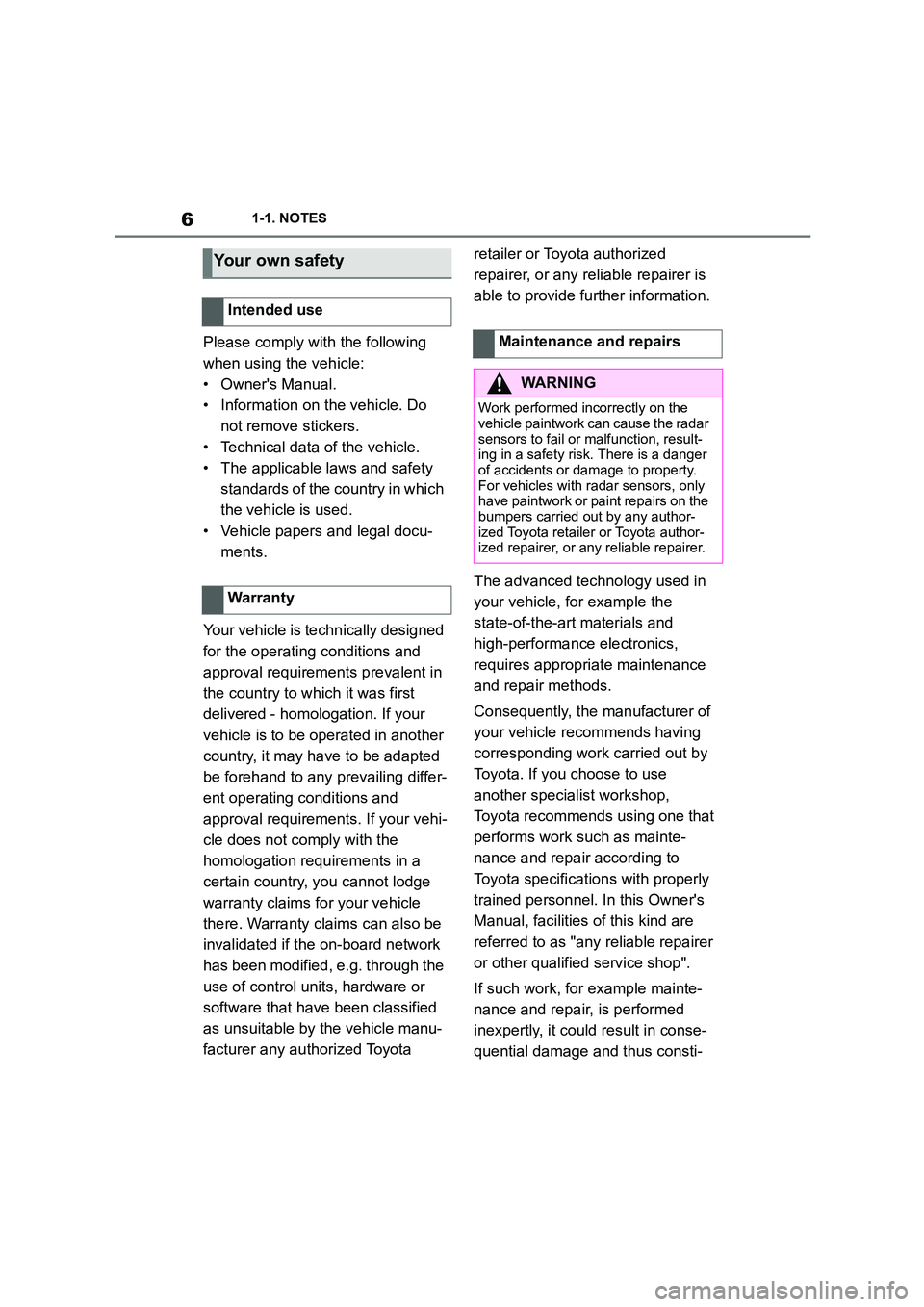
61-1. NOTES
Please comply with the following
when using the vehicle:
• Owner's Manual.
• Information on the vehicle. Do
not remove stickers.
• Technical data of the vehicle.
• The applicable laws and safety
standards of the country in which
the vehicle is used.
• Vehicle papers and legal docu-
ments.
Your vehicle is technically designed
for the operating conditions and
approval requirements prevalent in
the country to which it was first
delivered - homologation. If your
vehicle is to be operated in another
country, it may have to be adapted
be forehand to any prevailing differ-
ent operating conditions and
approval requirements. If your vehi-
cle does not comply with the
homologation requirements in a
certain country, you cannot lodge
warranty claims for your vehicle
there. Warranty claims can also be
invalidated if the on-board network
has been modified, e.g. through the
use of control units, hardware or
software that have been classified
as unsuitable by the vehicle manu-
facturer any authorized Toyota
retailer or Toyota authorized
repairer, or any reliable repairer is
able to provide further information.
The advanced technology used in
your vehicle, for example the
state-of-the-art materials and
high-performance electronics,
requires appropriate maintenance
and repair methods.
Consequently, the manufacturer of
your vehicle recommends having
corresponding work carried out by
Toyota. If you choose to use
another specialist workshop,
Toyota recommends using one that
performs work such as mainte-
nance and repair according to
Toyota specifications with properly
trained personnel. In this Owner's
Manual, facilities of this kind are
referred to as "any reliable repairer
or other qualified service shop".
If such work, for example mainte-
nance and repair, is performed
inexpertly, it coul d result in conse-
quential damage and thus consti-
Your own safety
Intended use
Warranty
Maintenance and repairs
WA R N I N G
Work performed incorrectly on the
vehicle paintwork can cause the radar
sensors to fail or malfunction, result- ing in a safety risk. There is a danger
of accidents or damage to property.
For vehicles with radar sensors, only have paintwork or paint repairs on the
bumpers carried out by any author-
ized Toyota retailer or Toyota author- ized repairer, or any reliable repairer.
Page 9 of 498
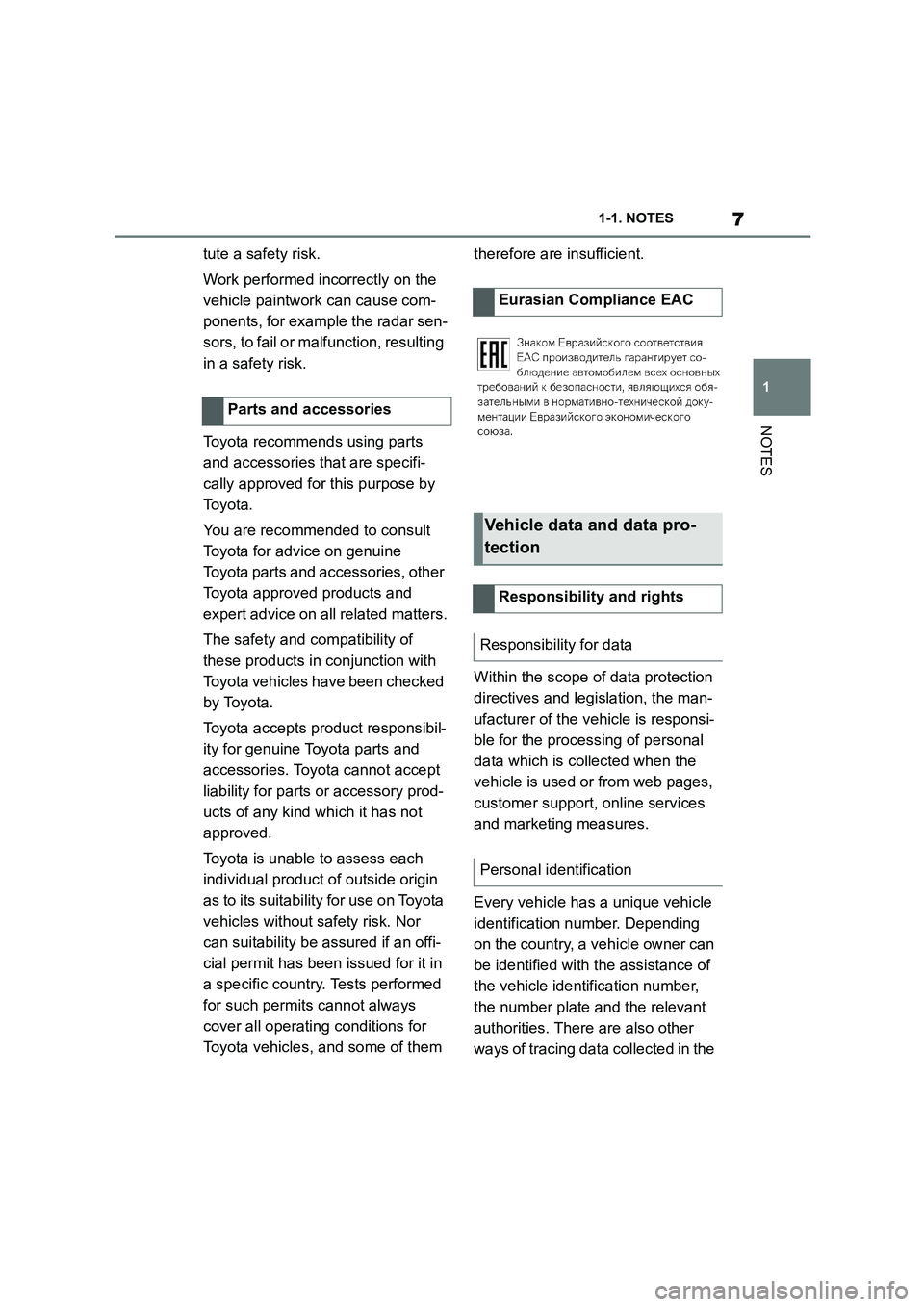
7
1
1-1. NOTES
NOTES
tute a safety risk.
Work performed incorrectly on the
vehicle paintwork can cause com-
ponents, for example the radar sen-
sors, to fail or malfunction, resulting
in a safety risk.
Toyota recommends using parts
and accessories that are specifi-
cally approved for this purpose by
To y o t a .
You are recommended to consult
Toyota for advice on genuine
Toyota parts and accessories, other
Toyota approved products and
expert advice on all related matters.
The safety and compatibility of
these products in conjunction with
Toyota vehicles have been checked
by Toyota.
Toyota accepts product responsibil-
ity for genuine Toyota parts and
accessories. Toyota cannot accept
liability for parts or accessory prod-
ucts of any kind which it has not
approved.
Toyota is unable to assess each
individual product of outside origin
as to its suitability for use on Toyota
vehicles without safety risk. Nor
can suitability be assured if an offi-
cial permit has been issued for it in
a specific country. Tests performed
for such permits cannot always
cover all operatin g conditions for
Toyota vehicles, and some of them
therefore are insufficient.
Within the scope of data protection
directives and legislation, the man-
ufacturer of the vehicle is responsi-
ble for the processing of personal
data which is co llected when the
vehicle is used or from web pages,
customer support, online services
and marketing measures.
Every vehicle has a unique vehicle
identification number. Depending
on the country, a vehicle owner can
be identified with the assistance of
the vehicle identification number,
the number plate and the relevant
authorities. There are also other
ways of tracing data collected in the
Parts and accessories
Eurasian Compliance EAC
Vehicle data and data pro-
tection
Responsibility and rights
Responsibility for data
Personal identification
Page 12 of 498
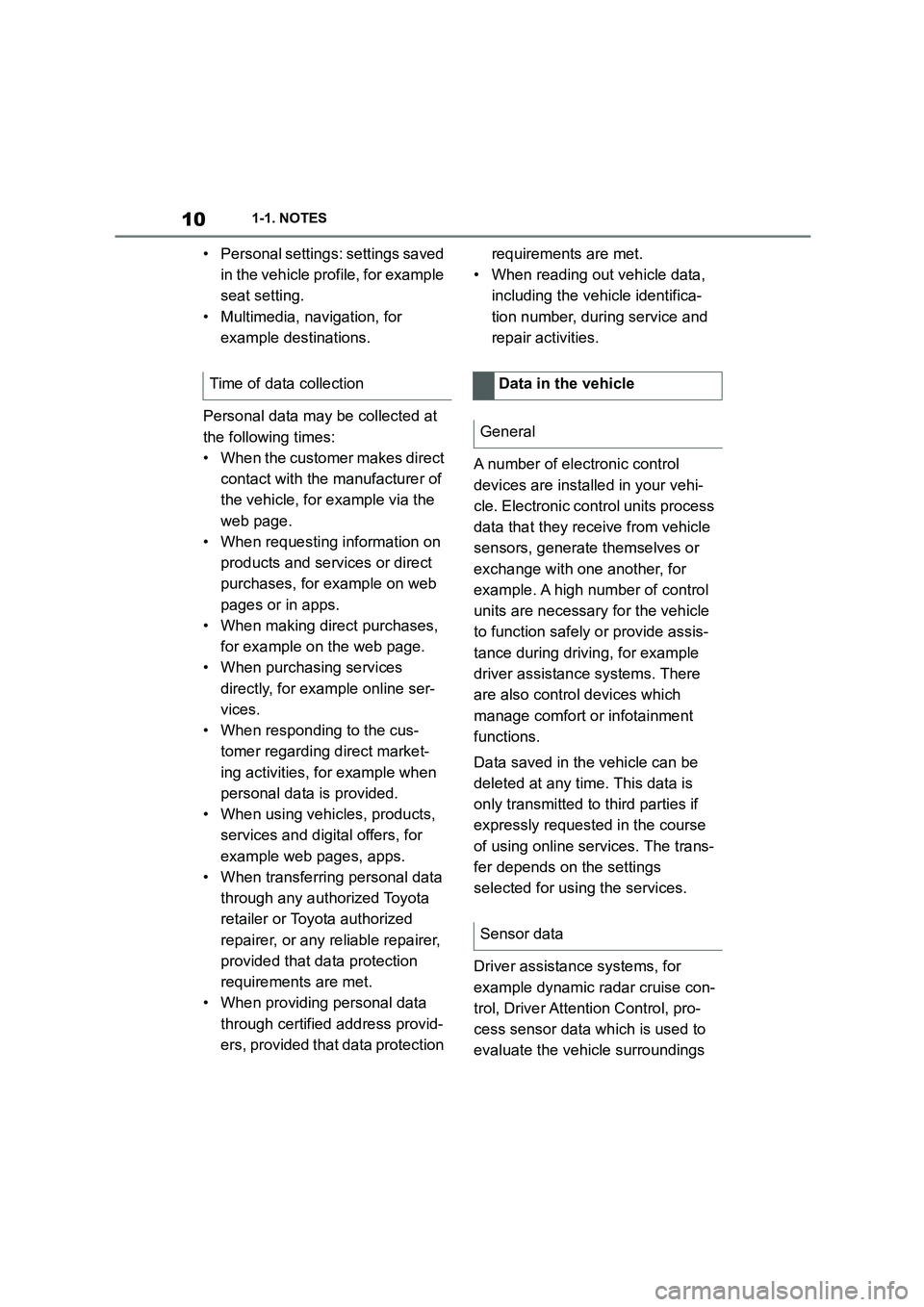
101-1. NOTES
• Personal settings: settings saved
in the vehicle profile, for example
seat setting.
• Multimedia, navigation, for
example destinations.
Personal data may be collected at
the following times:
• When the customer makes direct
contact with the manufacturer of
the vehicle, for example via the
web page.
• When requesting information on
products and services or direct
purchases, for example on web
pages or in apps.
• When making direct purchases,
for example on the web page.
• When purchasing services
directly, for example online ser-
vices.
• When responding to the cus-
tomer regarding direct market-
ing activities, for example when
personal data is provided.
• When using vehicles, products,
services and digital offers, for
example web pages, apps.
• When transferring personal data
through any authorized Toyota
retailer or Toyota authorized
repairer, or any reliable repairer,
provided that data protection
requirements are met.
• When providing personal data
through certified address provid-
ers, provided that data protection
requirements are met.
• When reading out vehicle data,
including the vehicle identifica-
tion number, during service and
repair activities.
A number of electronic control
devices are installed in your vehi-
cle. Electronic control units process
data that they receive from vehicle
sensors, generate themselves or
exchange with one another, for
example. A high number of control
units are necessary for the vehicle
to function safely or provide assis-
tance during driv ing, for example
driver assistance systems. There
are also control devices which
manage comfort or infotainment
functions.
Data saved in the vehicle can be
deleted at any time. This data is
only transmitted to third parties if
expressly requested in the course
of using online services. The trans-
fer depends on the settings
selected for using the services.
Driver assistance systems, for
example dynamic radar cruise con-
trol, Driver Attention Control, pro-
cess sensor data which is used to
evaluate the vehicle surroundings
Time of data collectionData in the vehicle
General
Sensor data
Page 13 of 498
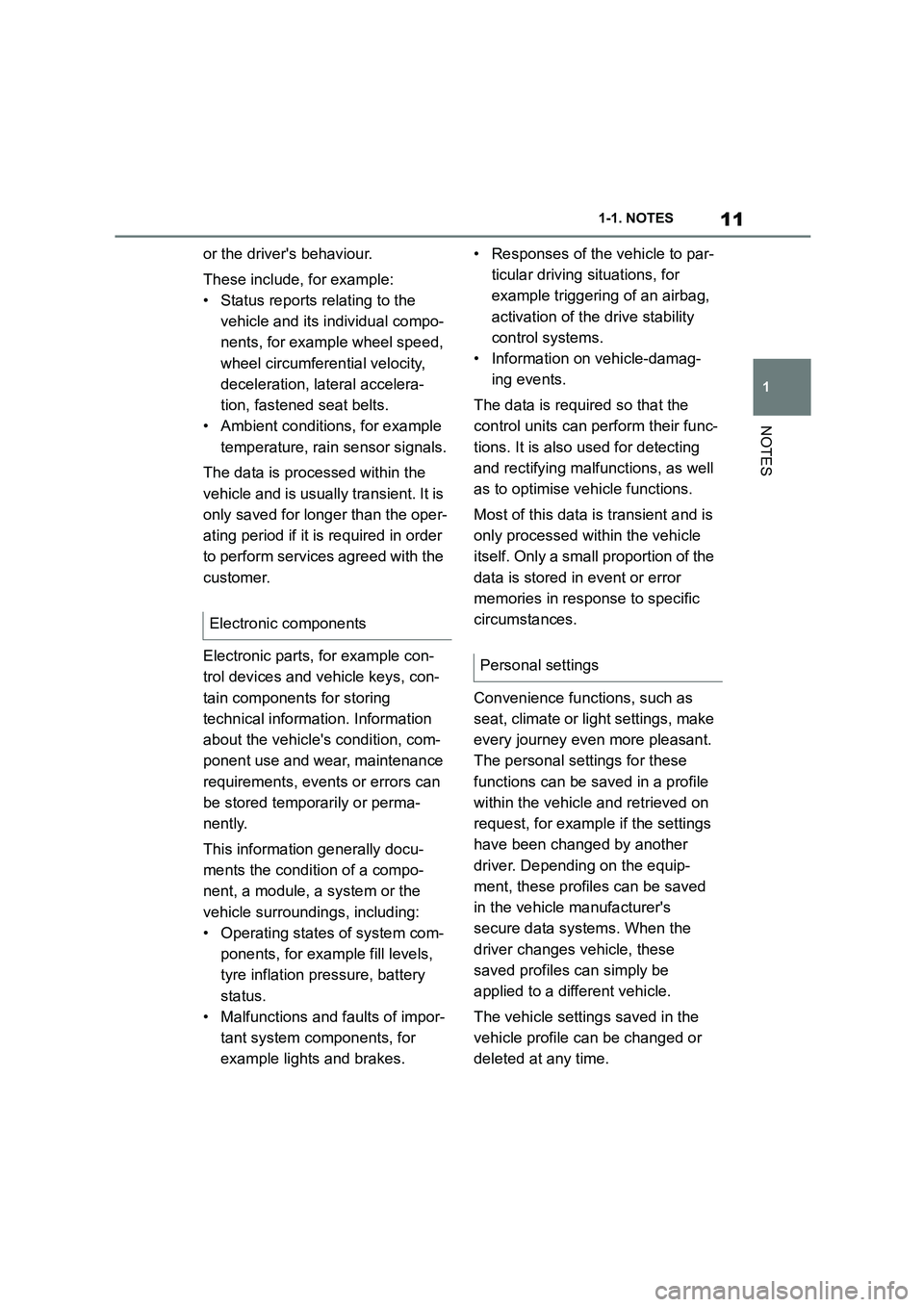
11
1
1-1. NOTES
NOTES
or the driver's behaviour.
These include, for example:
• Status reports relating to the
vehicle and its individual compo-
nents, for example wheel speed,
wheel circumferential velocity,
deceleration, lateral accelera-
tion, fastened seat belts.
• Ambient conditions, for example
temperature, rain sensor signals.
The data is processed within the
vehicle and is usually transient. It is
only saved for longer than the oper-
ating period if it is required in order
to perform services agreed with the
customer.
Electronic parts, for example con-
trol devices and vehicle keys, con-
tain components for storing
technical informat ion. Information
about the vehicle's condition, com-
ponent use and wear, maintenance
requirements, events or errors can
be stored temporarily or perma-
nently.
This information generally docu-
ments the condition of a compo-
nent, a module, a system or the
vehicle surroundings, including:
• Operating states of system com-
ponents, for examp le fill levels,
tyre inflation pr essure, battery
status.
• Malfunctions and faults of impor-
tant system components, for
example lights and brakes.
• Responses of the vehicle to par-
ticular driving situations, for
example triggering of an airbag,
activation of th e drive stability
control systems.
• Information on vehicle-damag-
ing events.
The data is required so that the
control units can perform their func-
tions. It is also used for detecting
and rectifying malfunctions, as well
as to optimise vehicle functions.
Most of this data is transient and is
only processed within the vehicle
itself. Only a small proportion of the
data is stored in event or error
memories in response to specific
circumstances.
Convenience functions, such as
seat, climate or light settings, make
every journey even more pleasant.
The personal settings for these
functions can be saved in a profile
within the vehicle and retrieved on
request, for example if the settings
have been changed by another
driver. Depending on the equip-
ment, these profiles can be saved
in the vehicle manufacturer's
secure data systems. When the
driver changes vehicle, these
saved profiles can simply be
applied to a different vehicle.
The vehicle settings saved in the
vehicle profile can be changed or
deleted at any time.
Electronic components
Personal settings
Page 16 of 498
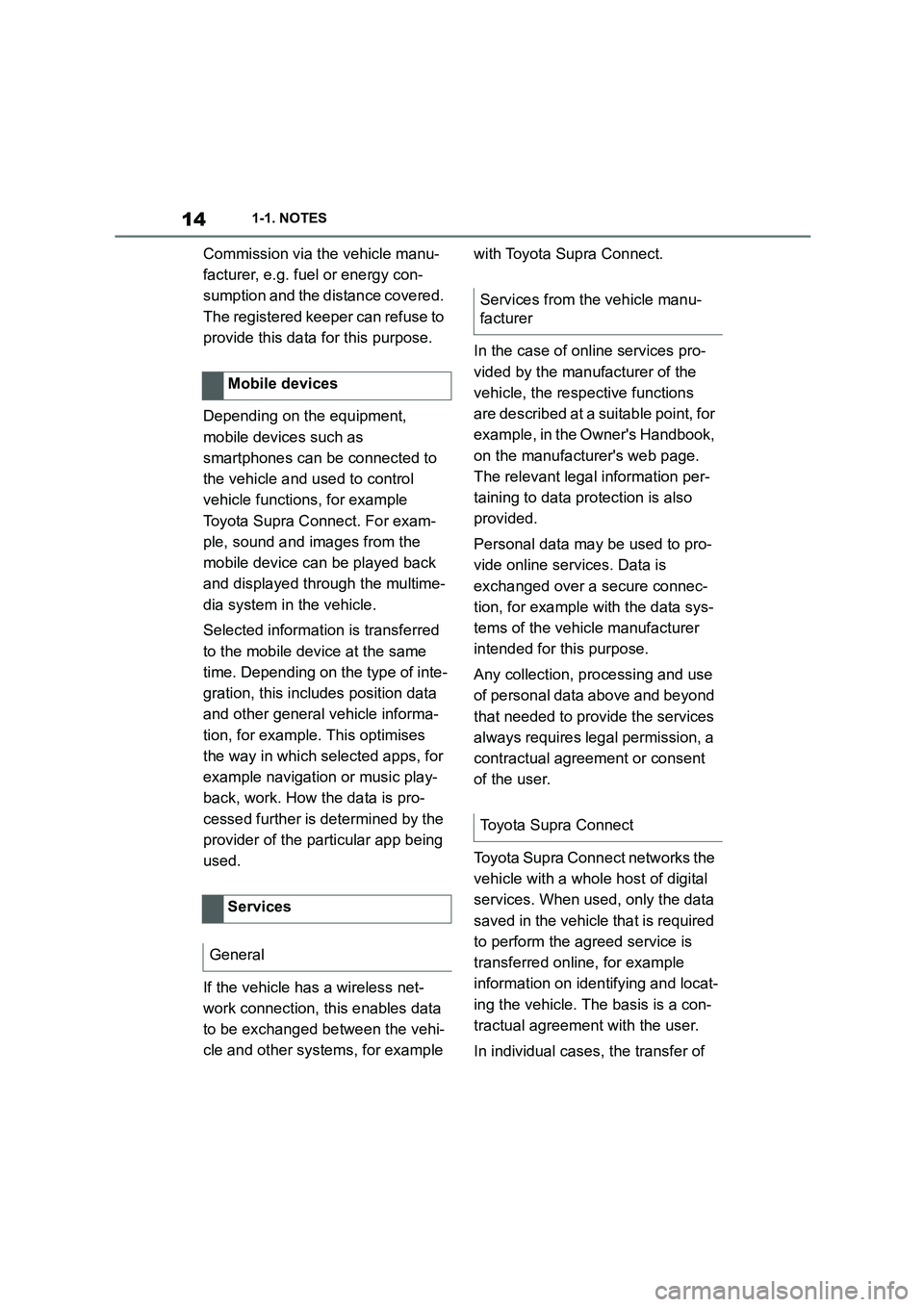
141-1. NOTES
Commission via the vehicle manu-
facturer, e.g. fuel or energy con-
sumption and the distance covered.
The registered keeper can refuse to
provide this data for this purpose.
Depending on the equipment,
mobile devices such as
smartphones can be connected to
the vehicle and used to control
vehicle functions, for example
Toyota Supra Connect. For exam-
ple, sound and images from the
mobile device can be played back
and displayed through the multime-
dia system in the vehicle.
Selected information is transferred
to the mobile device at the same
time. Depending on the type of inte-
gration, this includes position data
and other general vehicle informa-
tion, for example. This optimises
the way in which selected apps, for
example navigation or music play-
back, work. How the data is pro-
cessed further is determined by the
provider of the particular app being
used.
If the vehicle has a wireless net-
work connection, this enables data
to be exchanged between the vehi-
cle and other systems, for example
with Toyota Supra Connect.
In the case of online services pro-
vided by the manufacturer of the
vehicle, the respective functions
are described at a suitable point, for
example, in the Owner's Handbook,
on the manufacturer's web page.
The relevant legal information per-
taining to data protection is also
provided.
Personal data may be used to pro-
vide online services. Data is
exchanged over a secure connec-
tion, for example with the data sys-
tems of the vehicle manufacturer
intended for this purpose.
Any collection, processing and use
of personal data above and beyond
that needed to provide the services
always requires legal permission, a
contractual agreement or consent
of the user.
Toyota Supra Conn ect networks the
vehicle with a whole host of digital
services. When used, only the data
saved in the vehicle that is required
to perform the agreed service is
transferred online, for example
information on iden tifying and locat-
ing the vehicle. The basis is a con-
tractual agreement with the user.
In individual cases, the transfer of
Mobile devices
Services
General
Services from the vehicle manu-
facturer
Toyota Supra Connect
Page 17 of 498

15
1
1-1. NOTES
NOTES
data is triggered as a result of
predefined events, such as an
automatic emergency call. The
wireless network connection is
established via an in-vehicle trans-
mitter and receiver unit or via per-
sonal mobile devices brought into
the vehicle, for example
smartphones. Data transfer can be
deactivated on request.
The wireless network connection
enables online functions to be
used. These include online services
and apps supplied by the vehicle
manufacturer or by other providers.
When using online services from
other providers, these services are
the responsibility of the relevant
provider and subject to their data
privacy conditions and terms of
use. The vehicle manufacturer has
no influence over the data that is
exchanged.
Information as to how personal
data is collected and used in rela-
tion to services from third parties,
the scope of such data and its pur-
pose, can be obtained from the rel-
evant provider.
Every user decides for themselves
whether they wish to enter into a
contract for a service such as
Toyota Supra Connect. Information
is provided in writing regarding the
scope and content of data process-
ing before the service is acquired
and forms part of the vehicle hand-
over.
The user has the option to deacti-
vate the services at any time and,
as a result, to stop the processing
of data required fo r the services. It
is also possible to have the entire
data connection activated or deacti-
vated. Excluded from this are func-
tions and services which are
required by law, for example emer-
gency call systems.
CarData provides transparency
regarding how vehicle data is han-
dled when Toyota Supra Connect is
used. CarData enables users to
control whether vehicle data that is
processed in the context of Toyota
Supra Connect is transferred to
third parties. Users can decide for
each individual service offering
whether data access is to be
granted or refused for third parties,
for example for insurance compa-
nies.
An archive from CarData can also
be requested at any time. The
archive provides information
regarding the data that has been
transmitted and saved in the con-
text of Toyota Supra Connect. Car-
Data can only be accessed by
Services from other providers
Personal decision
Transparency concerning vehicle
data
Page 22 of 498
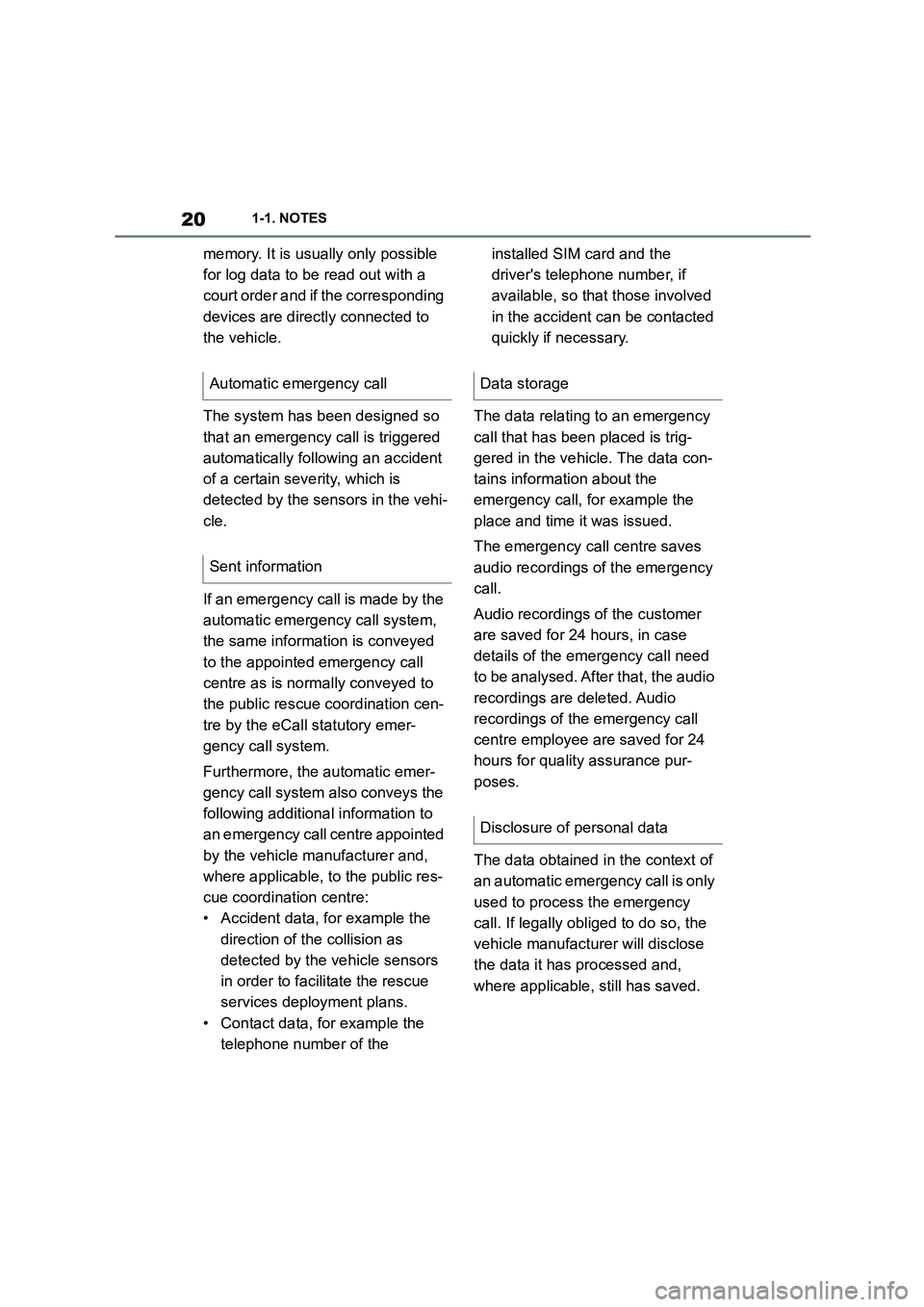
201-1. NOTES
memory. It is usually only possible
for log data to be read out with a
court order and if the corresponding
devices are directly connected to
the vehicle.
The system has been designed so
that an emergency call is triggered
automatically following an accident
of a certain severity, which is
detected by the sensors in the vehi-
cle.
If an emergency call is made by the
automatic emergency call system,
the same information is conveyed
to the appointed emergency call
centre as is normally conveyed to
the public rescue coordination cen-
tre by the eCall statutory emer-
gency call system.
Furthermore, the automatic emer-
gency call system also conveys the
following additional information to
an emergency call centre appointed
by the vehicle manufacturer and,
where applicable, to the public res-
cue coordination centre:
• Accident data, for example the
direction of th e collision as
detected by the vehicle sensors
in order to facilitate the rescue
services deployment plans.
• Contact data, for example the
telephone number of the
installed SIM card and the
driver's telephone number, if
available, so that those involved
in the accident can be contacted
quickly if necessary.
The data relating to an emergency
call that has been placed is trig-
gered in the vehicle. The data con-
tains information about the
emergency call, for example the
place and time it was issued.
The emergency call centre saves
audio recordings of the emergency
call.
Audio recordings of the customer
are saved for 24 hours, in case
details of the emergency call need
to be analysed. A fter that, the audio
recordings are deleted. Audio
recordings of the emergency call
centre employee are saved for 24
hours for quality assurance pur-
poses.
The data obtained in the context of
an automatic emergency call is only
used to process the emergency
call. If legally obliged to do so, the
vehicle manufactur er will disclose
the data it has processed and,
where applicable , still has saved.
Automatic emergency call
Sent information
Data storage
Disclosure of personal data
Page 28 of 498
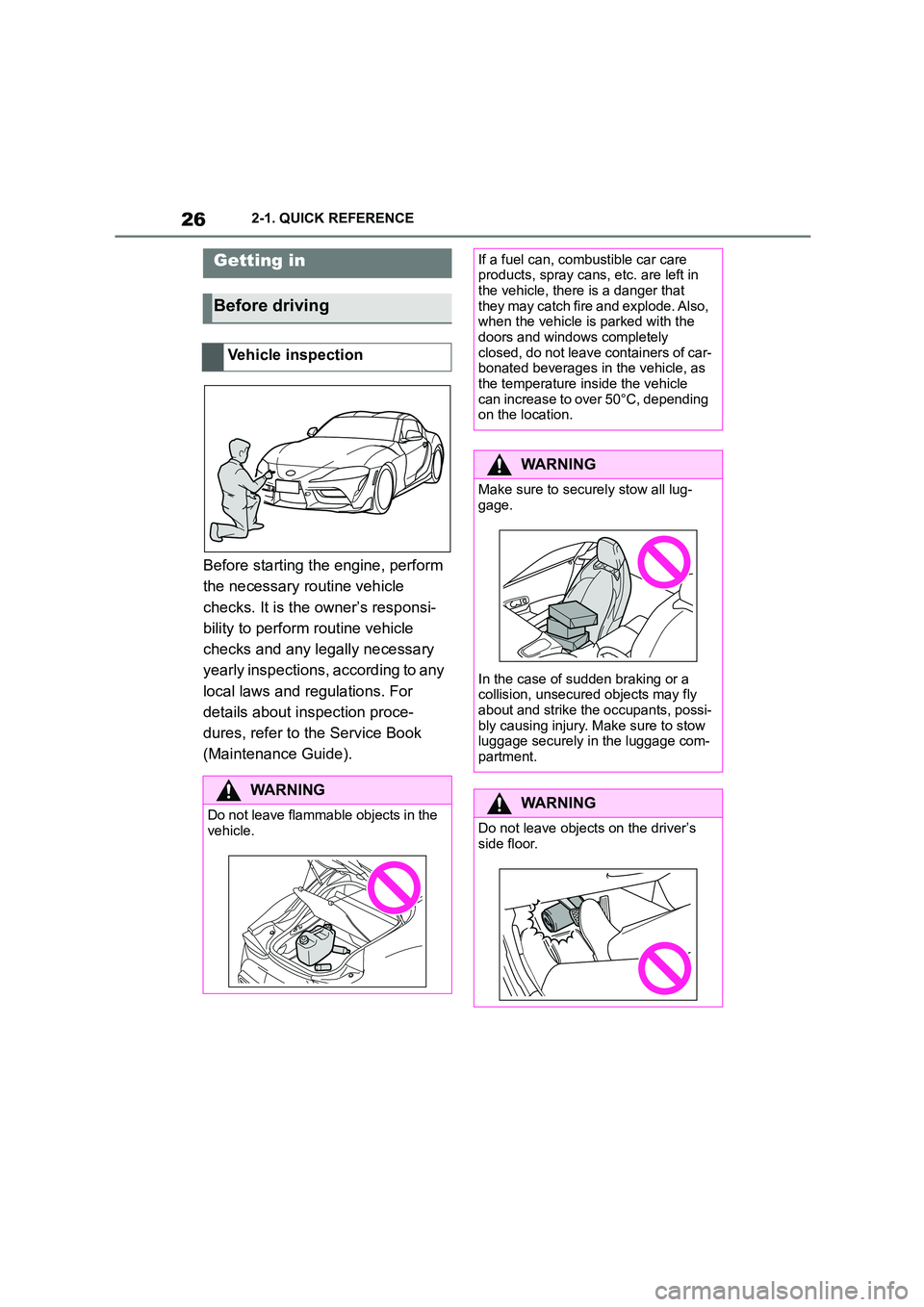
262-1. QUICK REFERENCE
2-1.QUICK REFERENCE
Before starting the engine, perform
the necessary routine vehicle
checks. It is the owner’s responsi-
bility to perform routine vehicle
checks and any legally necessary
yearly inspections, according to any
local laws and regulations. For
details about inspection proce-
dures, refer to the Service Book
(Maintenance Guide).
Getting in
Before driving
Vehicle inspection
WA R N I N G
Do not leave flammable objects in the vehicle.
If a fuel can, combustible car care products, spray cans, etc. are left in
the vehicle, there is a danger that
they may catch fire and explode. Also, when the vehicle is parked with the
doors and windows completely
closed, do not leave containers of car- bonated beverages in the vehicle, as
the temperature inside the vehicle
can increase to over 50°C, depending on the location.
WA R N I N G
Make sure to secu rely stow all lug-
gage.
In the case of sudden braking or a
collision, unsecure d objects may fly
about and strike the occupants, possi- bly causing injury. Ma ke sure to stow
luggage securely in the luggage com-
partment.
WA R N I N G
Do not leave objects on the driver’s
side floor.
Page 37 of 498

35
2
2-1. QUICK REFERENCE
QUICK REFERENCE
phone assigned to the tele-
phone function.
To establish the connection via the
additional telephone:
1 Press the button.
2 "Call via"
*: if equipped
CarPlay makes it possible to oper-
ate certain functions of a compati-
ble Apple iPhone by Siri voice
operation and using Toyota Supra
Command.
• Compatible iPhone, iPhone 5 or
later with iOS 7.1 or later.
• Corresponding mobile radio con-
tract.
• Bluetooth, Wi-Fi and Siri voice
operation are activated on the
iPhone.
Via Toyota Supra Command:
1 "My Vehicle"
2 "System settings"
3 "Mobile devices"
4 "Settings"
5 Select the following settings:
"Bluetooth"
"Apple CarPlay"
Register iPhone via Bluetooth on
the vehicle.
Select CarPlay as the function:
"Apple CarPlay"
The iPhone is connected to the
vehicle and displayed in the device
list.
Apple CarPlay preparation*
Principle
Operating requirements
Switching on Bluetooth and
CarPlay
Registering iPhone with CarPlay